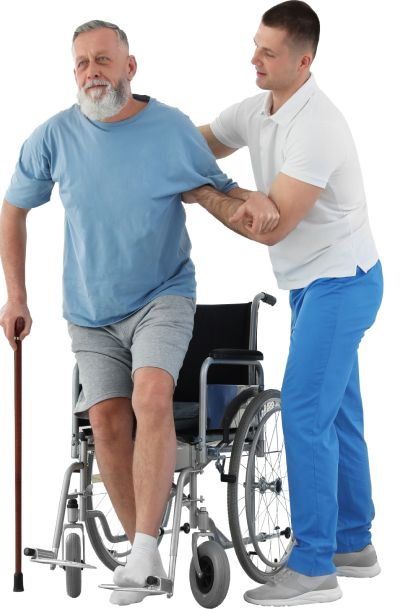This website uses cookies so that we can provide you with the best user experience possible. Cookie information is stored in your browser and performs functions such as recognising you when you return to our website and helping our team to understand which sections of the website you find most interesting and useful.
Home Care In Lake Elsinore, CA

They say that your golden years are the best years of your life. For most older Americans, that's how it should be - a time to relax, reflect, and live life in a familiar place. After all, senior citizens in the U.S. have worked tirelessly to build a better economy, serve their communities, and raise families.
However, as seniors grow older, completing daily tasks like showering and enjoying activities such as visiting the historic Tank House gets harder without someone by their side. Unfortunately, many older Americans aren't able to rely on their adult children for help. The reality in today's world is that family members do not have the skills or time to dedicate to caring for their parents. That's where Always Best Care Senior Services comes in.
Our in-home care services are for people who prefer to stay at home as they grow older but need ongoing care that family or friends cannot provide. More and more older adults prefer to live far away from long-term, institutionalized facilities and closer to the place where they feel most comfortable - their home. Home care in Lake Elsinore, CA is a safe, effective way to give your loved ones the care they need when they need it the most.

 Home Care Services
Home Care Services
- Home Care in Lake Elsinore, CA
- The Always Best Care Difference
- Types of In-home Care in Lake Elsinore, CA
- Benefits of Home Care in Lake Elsinore, CA
- Aging in Place: The Preferred Choice for Most Seniors
- Affordable Care Plans
- Compassionate Care. Trusted Caregivers
- Assisted Living Referral Services
- Taking the First Step with Always Best Care
 Service Areas
Service Areas
The Always Best Care Difference
Since 1996, Always Best Care has provided non-medical in-home care for seniors to help them maintain a healthy lifestyle as they get older. We are proud to have helped more than 25,000 seniors maintain higher levels of dignity and respect. We focus on providing seniors with the highest level of in-home care available so that they may live happily and independently.
Unlike some senior care companies, we genuinely want to be included in our clients' lives. We believe that personalized care is always the better option over a "one size fits all" approach. To make sure our senior clients receive the best care possible, we pair them with compassionate caregivers who understand their unique needs. That way, they may provide care accordingly without compromising their wellbeing.
The Always Best Care difference lies in life's little moments - where compassionate care and trustworthy experience come together to help seniors live a fruitful, healthy life. Whether you are an aging adult that can't quite keep up with life's daily tasks or the child of a senior who needs regular in-home services, Always Best Care is here to help.
“Thank you Tracy for helping me get through the hardest days of my life. Your”
“Tracy of Always Best Care was exceptionally helpful in finding a placement for my mom.”
“Rebecca did such an amazing job helping me find Placement for my sweet friend who”
“I have worked with Always Best Care for years and with three different family members.”
“When we found that we were unable to care for my husband Tracy provided timely”
“Tracey was very helpful, knowledgeable and empathetic. Highly recommend”
“From the very beginning, for about a year I spoke with Tracy Durling about my”
“During the busy holiday season Rebecca was helpful in finding me a nurse to assist”
“Our ABC caregiver has been excellent. He treats my mentally and physically disabled husband with”
“The group at Always Best Care was so helpful and knowledgable in helping us find”
“Absolutely exceptional!! I was in a bind, needed last minute weekend care for my”
“Rebecca and team could not have been more compassionate, caring and professional when we reached”
“Tracy Durling was referred to us by an acute rehab center Dad was at. She”
“Tracy was personable, professional, and knowledgeable in assessing needs and preferences to provide appropriate care”
“ABC has provided care for my mom for over 5 years. They are excellent. Whenever”
“Let me say that my experience with Always Best Care out of the gate has”
“I was extremely pleased with the level of expertise Always Best Care provided when our”
“Owner, Rebecca is amazing. Had a clients primary caregiver suddenly pass and she had someone”
“Owner, Rebecca is amazing. Had a clients primary caregiver suddenly pass and she had someone”
“Highly recommend the entire team at Always Best Care in Temecula! We knew absolutely nothing”
“Rebecca does amazing work at ABC. She is very compassionate & knowledgeable. Always making sure”
“Although my wife and I are not quite ready for in-home care services, we like”
“Always Best, specifically Rebecca, was there when I needed them. I was given information to”
“After my dad was hospitalized and needing 24 hour care, I got in touch with”
“After a great deal of research to pick a home care service for my mother-in-law”
“Rebecca and her team are astoundingly helpful. Having worked in senior care for 10 years”
“Without Tracy, not sure how we would have gotten the time, care, and understanding of”
“Rebecca is incredible and helped me relocate my mother with dementia from Seattle to Murrieta.”
“Always Best Care has been a blessing for my Mother. Mom was very”
“I was very pleased with the care my brother received from always best care services.”
“I had another person recommend a place 43 miles from my home after telling her”
“I live out of state and for the first time needed to find temporary in-home”
“We had such a wonderful Caregiver come to help with my mom on Christmas Day!”
“My husband, Don was recently a patient of Best Care until his passing. They were”
“I started my Residential Care Facility For the Elderly last 10/2022 and the first agent”
“Jazell is amazing, a great communicator, and her mom loves her. Thanks for all”
“Patti & I are doing well thanks, in large part, to Jeanine's excellent care. You”
“As an owner of a Residential Care Facility for the Elderly, I have utilized Always”
“I highly recommend Always Best Care of Temecula. They give outstanding service from the”
“As families make meaningful and tough decisions for their loved ones , it’s not easy”
“Jazell is amazing, a great communicator, and her mom loves her. Thanks for all”
“Patti & I are doing well thanks, in large part, to Jeanine's excellent care. You”
“Exceptional in-home senior care agency in Temecula. Their team exemplifies unmatched competence, providing compassionate care”
“Rebecca and Holly and team are the best! I’ve worked for two other companies in”
“Rebecca and her team at Always Best Care in Temecula are the kindest, caring and”
“Always best care is a wonderful place to work for. Holly and Rebecca,”
“trustworthy and compassionate senior care in Temecula. this company will exceed your expectations! ”
“Always Best Care was amazing with helping me find a board and care for my”
“I needed an occasional helping hand after a surgery. This company quickly sent a representative”
“I have used Always Best Care for several years now. The caregivers are always kind”
“Thank you Tracy for helping me get through the hardest days of my life. Your compassion and understanding are so commendable. I highly recommend you.”
“Tracy of Always Best Care was exceptionally helpful in finding a placement for my mom. She listened and found me two senior care locations to view. This has been an incredibly easy transition for our family bringing her closer to us in Menifee.”
“Rebecca did such an amazing job helping me find Placement for my sweet friend who was on a very limited budget! I highly recommend Rebecca.”
“I have worked with Always Best Care for years and with three different family members. I’ve had the pleasure of working with Rebecca and Tracy who are both compassionate and supportive to both the patient and the family members. Their service truly goes above and beyond. We needed specific care for my father and they found us the perfect group home for him, they were amazing and as my mom was recovering ❤️???? from heart surgery she joined him there. After losing my dad in Dec of ‘23 when my mom was ready Tracy recommended the perfect Assisted Living Facility in Murrieta for her. While it’s an inevitable new chapter Tracy has even checked in to see how she is doing. I cannot recommend them enough! Our entire family is so grateful to Always Best Care!”
“When we found that we were unable to care for my husband Tracy provided timely options in a clean and caring home. As we are on ssi she also took our ability to pay into consideration. The caretakers are kind and knowledgeable in basic, safe care.”
“Tracey was very helpful, knowledgeable and empathetic. Highly recommend”
“From the very beginning, for about a year I spoke with Tracy Durling about my mom’s situation. Tracy came over and met my mom and we started talking about different assisted living facilities in the area. After about a year we finally were easy to tour some facilities and we decided on one, which was one that Tracy highly recommended. My mom have been there for about 7 months now and she loves it there. If it wasn’t for Tracy and her knowledge of these facilities and the huge heart she has to help people, I truly don’t know how I would have done this on my own. If anyone is looking to put a loved one in assisted living or even have home care, I would most definitely call Always Best Care Senior Services, they are the best and go out of their way to meet your needs.”
“During the busy holiday season Rebecca was helpful in finding me a nurse to assist with my grandfather to allow us to have him outside of the memory care facility for the holidays. Rebecca was thorough, compassionate, understanding and very successful at finding us an option that fit our needs in a short request window during a very busy season. I am so thankful for my grandfathers hospices providers recommendation to reach out to Always Best Care.”
“Our ABC caregiver has been excellent. He treats my mentally and physically disabled husband with respect, dignity, and kindness. My husband can be aggressive and angry, but our ABC caregiver has the experience to handle the situation and keep them both safe. This is unlike other caregiving services we have employed, where caregivers just walked out once they found out my husband could get aggressive. I would highly recommend ABC for the care of your loved one.”
“The group at Always Best Care was so helpful and knowledgable in helping us find senior care for my mother quickly. They made excellent recommendations that fit our needs. Tracy was wonderful to work with mom and family.”
“Absolutely exceptional!! I was in a bind, needed last minute weekend care for my mom that had surgery. ABCS came to the rescue with extremely kind and dedicated healthcare workers. Their communication was also out of this world! I’d give them 6 stars if I could!”
“Rebecca and team could not have been more compassionate, caring and professional when we reached out for some help with my Dad after a rough hip replacement surgery. I highly recommend them for any type of Senior Care services.”
“Tracy Durling was referred to us by an acute rehab center Dad was at. She was a wealth of information, full of compassion, and a godsend to us during a difficult time for our family.Through her we found him placement at an excellent senior care facility in Murrieta.”
“Tracy was personable, professional, and knowledgeable in assessing needs and preferences to provide appropriate care for my husband, and her success in quickly finding the right placement was a blessing. I highly recommend Always Best Care to anyone seeking help in finding care for a loved one.”
“ABC has provided care for my mom for over 5 years. They are excellent. Whenever I have needed a higher level of care they provided experienced professional caregivers that were dependable and did a great job. I would highly recommend them!”
“Let me say that my experience with Always Best Care out of the gate has been absolutely tremendous extremely professional and knowledgeable. I had the pleasure of meeting Melanie Stout Who share with me the level of detail her company takes to guide families to make the best decisions that’s what’s most important to me and so important to those that I serve. I look forward to working with Melanie and the great team at Always Best Care in the coming weeks and months ahead, thank you Rick T.”
“I was extremely pleased with the level of expertise Always Best Care provided when our family needed to find assisted living for our Father. Tracy's follow up and genuine concern for his well being was so appreciated. I am very thankful for their dedicated.”
“Owner, Rebecca is amazing. Had a clients primary caregiver suddenly pass and she had someone there within hours. Like a fairy godmother waving a wand. Then!! She even assisted in helping find a respite care facility while clients home is being renovated. Seriously cannot go wrong with the care delivered. Every caregivers worth is shown in the way they perform. Will always recommend”
“Owner, Rebecca is amazing. Had a clients primary caregiver suddenly pass and she had someone there within hours. Like a fairy godmother waving a wand. Then!! She even assisted in helping find a respite care facility while clients home is being renovated. Seriously cannot go wrong with the care delivered. Every caregivers worth is shown in the way they perform. Will always recommend”
“Highly recommend the entire team at Always Best Care in Temecula! We knew absolutely nothing about in-home care when my mom fell ill, but Tracy came in and was a lifesaver. She was compassionate, thoughtful, full of information, and listened carefully to our needs and concerns and then took care of it. We never had to divert our attention away from mom because Tracy was on it. We needed 24/7 assistance, and every single caregiver who came in was so helpful and kind with my mom and with us. They took care of all of her needs and were so considerate to my dad's needs as well. I don't know how we would have gotten through her passing without these special people by our side. We were so impressed that we decided to continue with several of the caregivers to help with my dad's needs and his grief. They have been absolutely amazing with him. The communication with us is phenomenal, from the caregivers to the office team, so we are always kept in the loop. Holly and Rebecca have been beyond patient and have been so very friendly, understanding, and gracious with us and our many requests. We can't thank them enough for their support through these difficult and emotional times. Our family can always breathe just a little bit easier when the team is with him as we know he will be in good hands.”
“Rebecca does amazing work at ABC. She is very compassionate & knowledgeable. Always making sure all the needs of her clients are met in the best possible way. Highly recommended”
“Although my wife and I are not quite ready for in-home care services, we like to plan ahead. We had a lot of questions so we called Always Best Care. Holly was happy to answer all our inquiries. She was very patient with us even though we told her we were not ready to use them yet. We felt good about the info provided and will use their services if the need arises.”
“Always Best, specifically Rebecca, was there when I needed them. I was given information to help me make the best decisions for the care of my dad even if every option wasn’t income for Always Best. The nurses were wonderful, compassionate, comforting and extremely helpful as my dad’s health declined.”
“After my dad was hospitalized and needing 24 hour care, I got in touch with Rebecca at ABC. She was so knowledgeable and helpful with helping me find a safe place for my dad to go. What sets her apart from the other companies is that she is passionate about what she does. She truly wants the best for her elderly clients. I am an RN myself, and trust her 100%, I have seen firsthand that Rebecca will always do what’s best for the client even if it doesn’t benefit her. She even checks in on my dad from time to time and wishes him well. Thank you again Rebecca!”
“After a great deal of research to pick a home care service for my mother-in-law we chose this one. IT WAS A GREAT CHOICE! Melanie was our first point of contact and she made a GREAT first impression. With only a 1 day notice she was able to schedule Christina to spend a 16 hour shift with my mother-in-law overnight the first night she was home after 1 week in a Kaiser hospital and 2 weeks in a skilled nursing facility. My mother-in-law is sometimes very difficult to please, especially when she is spending money for ANY service! She was delighted with Christina and even gave her hugs when she left the next morning! We highly recommend Always Best Care!”
“Rebecca and her team are astoundingly helpful. Having worked in senior care for 10 years as an OT and now owner of a board and care, I can say with confidence that these are tremendous people. The caring way they guide seniors and their families through finding placement is top notch. I recommend anyone seeking a great helpful guide to reach out and get the help they deserve from this team.”
“Without Tracy, not sure how we would have gotten the time, care, and understanding of placement for mom. Senior care and assistant living facilities are not all the same. So glad we had Tracy to guide us through the process. Love moms permanent home in Murrieta!”
“Rebecca is incredible and helped me relocate my mother with dementia from Seattle to Murrieta. She had all the information about the local care community that I needed. She even jumped in and helped when I needed her most. I would totally recommend Rebecca and her team to anyone with an elder that has dementia and needs care.”
“Always Best Care has been a blessing for my Mother. Mom was very resistant to having someone in her house to help her. And don't use the word caregiver with Mom, that would set her off on a angry rant, she was convinced that she didn't need any help at all, but with Mom's developing dementia amongst other things she was forgetting to eat and drink on a regular basis, and if she did remember to eat she would put dirty dishes away in the cupboard. And there are many other examples of Mom truly needing help. Along comes Always Best Care and after a month or so, Mom now claims her caregiver is a "very good friend". A friend that she spends time with, and can talk with and who helps her with shopping etc. (she still does not use the word caregiver). Everyone at Always Best has been very accommodating. Holly in scheduling keeps me in the loop and is very easy to work with for schedule changes when I need them. I would recommend Always Best to anyone that is looking to take care of a loved one in need. Sincerely, Joe”
“I was very pleased with the care my brother received from always best care services. The caregivers where outstanding, loving and clean. This company wants nothing but the best for the residents and the families. I always felt very connected with the staff. They always kept the family aware of the residents needs. Thank you Rebecca”
“I had another person recommend a place 43 miles from my home after telling her what I needed, which was not helpful. I spoke to Rebecca about two weeks ago and explained I live in Temecula and needed senior home care for my brother closer to me, because he currently lives in Corona. She listened carefully to my concerns and needs, and suggested a home in Murrieta, 8 miles away that worked out perfectly! Very helpful and I highly recommend Always Best Care!”
“I live out of state and for the first time needed to find temporary in-home care for my elderly parents in Murrieta. Tracy came to our home and put my parents at ease explaining everything to them. Both of the caregivers we had were wonderful. I will definitely use Always Best Care again when the need arises.”
“We had such a wonderful Caregiver come to help with my mom on Christmas Day! Esmerelda was a God send!!! ABC was so helpful and provided us with such a sweet caregiver! Thank you Esmerelda and ABC for creating such a memorable holiday for our Family!❤️”
“My husband, Don was recently a patient of Best Care until his passing. They were wonderful, could not have asked for more dedicated and caring women to help my family thru the most difficult time of our lives. Thankyou.”
“I started my Residential Care Facility For the Elderly last 10/2022 and the first agent that came to visit my facility is Donna from Always Best Care Senior Services in Temecula. Donna was an amazing staff of the team, and she told me about the owner which is Rebecca and the rest of the team that worked with ABC. Finding a home for a love one is difficult to find unless you have an agency like Rebecca and her team in terms of placing elderly someone you can trust and this is the team that i trusted for finding patient for my homecare. I truly believed their remarkable work thru the years of experience and great communication. I highly recommend Always Best Care in Temecula. I thank you you so much Rebecca and Donna and the rest of your team for helping families for placing their love ones and owners of homecare like me for the support you have given me since I started to open my facility for the elderly.”
“Jazell is amazing, a great communicator, and her mom loves her. Thanks for all she does!”
“Patti & I are doing well thanks, in large part, to Jeanine's excellent care. You could not have a better representative for your company. She is wonderful with Patti. When Jeanine is around Patti is a different person. She is upbeat and happy much of the time. Jeanine is a self starter, she doesn't require supervision. She sees something that needs to be done and she does it. Together we have established a routine that makes my life much less stressful. Patti and I both tell her that regularly.”
“As an owner of a Residential Care Facility for the Elderly, I have utilized Always Best Care for my staffing needs for the last two years. Rebecca and her team have always been consistent, sent reliable staff and communicated with me the entire time! This is what sets them apart from any other staffing agency within a 40 mile radius. Thank you Rebecca and the entire Always Best Care staff for being nothing but amazing. You will always be my first choice when I have staffing needs.”
“I highly recommend Always Best Care of Temecula. They give outstanding service from the owner, Rebecca, to all the caregivers. I always know that my mother, who is 99 years old, is being assisted in her own home by a skilled and loving caregiver. That gives me great comfort.”
“As families make meaningful and tough decisions for their loved ones , it’s not easy to find the right expertise and support. I really appreciate Rebecca’s advice, recommendations and responsiveness. It was easy to navigate the website, fill out a request form or call. Rebecca spent time to talk with me about my family and what our options are. There aren’t many businesses or business owners willing to spend that type of quality time discussing or even provide expert knowledge based on her years of experience with elderly care. I can’t thank you enough Rebecca for your help. I plan to contact Rebecca for our family needs now and in the future.”
“Jazell is amazing, a great communicator, and her mom loves her. Thanks for all she does!”
“Patti & I are doing well thanks, in large part, to Jeanine's excellent care. You could not have a better representative for your company. She is wonderful with Patti. When Jeanine is around Patti is a different person. She is upbeat and happy much of the time. Jeanine is a self starter, she doesn't require supervision. She sees something that needs to be done and she does it. Together we have established a routine that makes my life much less stressful. Patti and I both tell her that regularly.”
“Exceptional in-home senior care agency in Temecula. Their team exemplifies unmatched competence, providing compassionate care that truly reflects their dedication to their clients. It's evident that they go above and beyond to ensure the well-being and comfort of those they serve.”
“Rebecca and Holly and team are the best! I’ve worked for two other companies in the area and hands-down prefer working for Always Best Care. The compassion, care, kindness, and patience I see exhibited by the entire team, warm my heart to know I am a part of this fantastic organization.”
“Rebecca and her team at Always Best Care in Temecula are the kindest, caring and most qualified home care agency! I have worked with Rebecca and her team for 7 years and love them! They are the best choice if you want the best care for your loved ones!”
“Always best care is a wonderful place to work for. Holly and Rebecca, are amazing, I also have had the pleasure of working with many wonderful families.”
“trustworthy and compassionate senior care in Temecula. this company will exceed your expectations! best in-home care provider in the area.”
“Always Best Care was amazing with helping me find a board and care for my mother. I first met with Tracy, and we set up for my mom to stay in her apartment with the help of caregivers. Before we were able to start, my mom had a few medical issues and could no longer live on her on. Charmain and Rebecca then helped find a place for my mom to live with caretakers helping her 24/7. We were in an emergency situation and they came through for us. Can't say enough good things about them.”
“I needed an occasional helping hand after a surgery. This company quickly sent a representative so we could decide on what was needed, and provided a smart, savvy, young woman, who was very helpful.”
“I have used Always Best Care for several years now. The caregivers are always kind and willing to help with all your needs and wants. I have tried a couple of other services in the past and had some really bad service. I would recommend Always Best Care to anyone.”
What is Non-Medical Senior Care in Lake Elsinore, CA?

Home is where the heart is. While that saying can sound a tad cliche, it is especially true for many seniors living in America. When given a choice, older adults most often prefer to grow older at home. An AARP study found that three out of four adults over the age of 50 want to stay in their homes and communities as they age.

When you begin to think about why, it makes sense. Home offers a sense of security, comfort, and familiarity.

The truth is, as we age, we begin to rely on others for help. When a family is too busy or lives too far away to fulfill this role, in-home senior care is often the best solution. Home care services allow seniors to enjoy personal independence while also receiving trustworthy assistance from a trained caregiver.

At Always Best Care, we offer a comprehensive range of home care services to help seniors stay healthy while they get the help they need to remain independent. As your senior loved one gets older, giving them the gift of senior care is one of the best ways to show your love, even if you live far away.

Types of Elderly Care in Lake Elsinore, CA
To give our senior clients the best care possible, we offer a full spectrum of in-home care services:

Personal Care Services
If your senior loved one has specific care needs, our personal care services are a great choice to consider. Personal care includes the standard caregiving duties associated with companion care and includes help with tasks such as dressing and grooming. Personal care can also help individuals with chronic conditions like diabetes.
Common personal care services include assistance with:
- Eating
- Mobility Issues
- Incontinence
- Bathing
- Dressing
- Grooming


Home Helper Services
Sometimes, seniors need helpful reminders to maintain a high quality of life at home. If you or your senior has trouble with everyday tasks like cooking, our home helper services will be very beneficial.
Common home helper care services include assistance with:
- Medication Reminders
- Meal Preparation
- Pet Care
- Prescription Refills
- Morning Wake-Up
- Walking
- Reading


Companionship Services
Using this kind of care is a fantastic way to make life easier for you or your senior loved one. At Always Best Care, our talented caregivers often fill the role of a companion for seniors. That way, older adults can enjoy their favorite local activities, such as visiting Lakepoint Park with friends while also receiving the care they need daily or weekly.
Common companionship services include:
- Grocery Shopping
- Transportation to Appointments
- Nutritional Assistance
- Conversation
- Planning Outings
- Completing Errands
- Transportation to Community
- Events and Social Outings


Respite Care Services
According to AARP, more than 53 million adults living in the U.S. provide care to someone over 50 years old. Unfortunately, these caregivers experience stress, exhaustion, and even depression. Our respite care services help family caregivers address urgent obligations, spend time with their children, and enjoy nearby activities. Perhaps more importantly, respite care gives family members time to recharge and regroup. Taking personal time to de-stress reduces the risk of caregiver burnout. So, if you've always wanted to eat at the local Vincenzo's Olive Tree or visit Armory Hall, don't feel bad. Doing so is great for both you and your loved one.
At the end of the day, our goal is to become a valuable part of your senior's daily routine. That way, we may help give them the highest quality of life possible. We know that staying at home is important for your loved one, and we are here to help make sure that is possible.
If you have been on the fence about non-medical home care, there has never been a better time than now to give your senior the care, assistance, and companionship they deserve.

Benefits of Home Care in Lake Elsinore, CA
Always Best Care in-home services are for older adults who prefer to stay at home but need ongoing care that friends and family cannot provide. In-home care is a safe, effective way for seniors to age gracefully in a familiar place and live independent, non-institutionalized lives. The benefits of non-medical home care are numerous. Here are just a few reasons to consider senior care services from Always Best Care:
Always Best Care offers a full array of care options for patients at all levels of health. With our trusted elderly care services, your loved one will receive the level of care necessary for them to enjoy the highest possible quality of life.
Request More Information
Aging in Place: The Preferred Choice for Most Seniors
While it's true that some seniors have complicated medical needs that prevent them from staying at home, aging in place is often the best arrangement for seniors and their families. With a trusted caregiver, seniors have the opportunity to live with a sense of dignity and do so as they see fit - something that is unavailable to many older people today.
In-home care makes it possible for millions of seniors to age in place every year. Rather than moving to a strange nursing home, seniors have the chance to stay at home where they feel the happiest and most comfortable.
Here are just a few of the reasons why older men and women prefer to age at home:
How much does a senior's home truly mean to them?
A study published by the American Society on Aging found that more than half of seniors say their home's emotional value means more than how much their home is worth in monetary value. It stands to reason, then, that a senior's home is where they want to grow old.
With the help of elderly care in Lake Elsinore, CA, seniors don't have to age in a sterilized care facility. Instead, they can age gracefully in the place they want to be most: their home. In contrast, seniors who move to a long-term care facility must adapt to new environments, new people, and new systems that the facility implements. At this stage in life, this kind of drastic change can be more harmful than helpful.
Institutional care facilities like nursing homes often put large groups of people together to live in one location. On any given day, dozens of staff members and caregivers run in and out of these facilities. Being around so many new people in a relatively small living environment can be dangerous for a seniors' health and wellbeing. When you consider that thousands of seniors passed away in nursing homes during the COVID-19 pandemic, opting for in-home care is often a safer, healthier choice for seniors.
Aging in place has been shown to improve seniors' quality of life, which helps boost physical health and also helps insulate them from viral and bacterial risks found in elderly living facilities.
For many seniors, the ability to live independently with assistance from a caregiver is a priceless option. With in-home care, seniors experience a higher level of independence and freedom - much more so than in other settings like a nursing home. When a senior has the chance to age in place, they get to live life on their own terms, inside the house that they helped make into a home. More independence means more control over their personal lives, too, which leads to increased levels of fulfillment, happiness, and personal gratification. Over time, these positive feelings can manifest into a healthier, longer life.
More independence, a healthier life, and increased comfort are only a few benefits of aging in place. You have to take into consideration the role of cost and convenience. Simply put, it's usually easier and more affordable to help seniors age in place than it is to move them into an institutional care facility. According to the US Department of Housing and Urban Development, seniors who age in the comfort of their homes can save thousands of dollars per month.
In-home care services from Always Best Care, for instance, are often less expensive than long-term solutions, which can cost upwards of six figures per year. To make matters worse, many residential care facilities are reluctant to accept long-term care insurance and other types of payment assistance.
With Always Best Care's home care services, seniors and their families have a greater level of control over their care plans. In-home care gives seniors the chance to form a bond with a trusted caregiver and also receive unmatched care that is catered to their needs. In long-term care facilities, seniors and their loved ones have much less control over their care plan and have less of a say in who provides their care.

Affordable Care
In-home care is a valuable resource that empowers seniors to age in place on their own terms. However, a big concern for many families and their loved ones is how much in-home care costs. If you're worried that in-home care is too expensive, you may be pleasantly surprised to learn that it is one of the most affordable senior care arrangements available.
Typically, hiring an Always Best Care in-home caregiver for a few hours a week is more affordable than sending your loved one to a long-term care facility. This is true even for seniors with more complex care needs.
At Always Best Care, we will work closely with you and your family to develop a Care Plan that not only meets your care needs, but your budget requirements, too. Once we discover the level of care that you or your senior need, we develop an in-home care plan that you can afford.
In addition to our flexible care options, families should also consider the following resources to help offset potential home care costs:

Compassionate Care. Trusted Caregivers.
When you or your senior loved one needs assistance managing daily tasks at home, finding a qualified caregiver can be challenging. It takes a special kind of person to provide reliable care for your senior loved one. However, a caregiver's role involves more than meal preparation and medication reminders. Many seniors rely on their caregivers for companionship, too.
Our companion care services give seniors the chance to socialize in a safe environment and engage in activities at home. These important efforts boost morale and provide much-needed relief from repetitive daily routines. A one-on-one, engaging conversation can sharpen seniors' minds and give them something in which to be excited.
At Always Best Care, we only hire care providers that we would trust to care for our own loved ones. Our senior caregivers in Lake Elsinore, CA understand how important it is to listen and communicate with their seniors. A seemingly small interaction, like a short hug goodbye, can make a major difference in a senior's day. Instead of battling against feelings of isolation, seniors begin to look forward to seeing their caregiver each week.
Understanding the nuances of senior care is just one of the reasons why our care providers are so great at their job.
Unlike some senior care companies, our caregivers must undergo extensive training before they work for Always Best Care. In addition, our caregivers receive ongoing training throughout the year. This training ensures that their standard of care matches up to the high standards we've come to expect. During this training, they will brush up on their communication skills, safety awareness, and symptom spotting. That way, your loved one receives the highest level of non-medical home care from day one.
Assisted Living Referral Services
While it's true that many seniors prefer to age at home, sometimes in-home care isn't the best fit. For those seniors and their families, choosing an assisted living facility makes more sense. Unfortunately, finding the optimal care facility is easier said than done in today's day and age. That's when Always Best Care's assisted living referral services begin to make a lot of sense.
Assisted living is a form of housing intended for seniors who require varying degrees of medical and personal attention. Accommodations may include single rooms, apartments, or shared living arrangements. Assisted living communities are typically designed to resemble a home-like environment and are physically constructed to encourage the independence of residents.

At assisted living communities, seniors receive help with daily activities such as bathing, dressing, and eating. They may also benefit from coordination of services with outside healthcare providers, and monitoring of resident activities to ensure their health, safety, and well-being. Caregivers who work at assisted living communities can also provide medication administration and personal care services for older adults.
Other services offered within assisted living communities can include some or all of the following:
- Housekeeping
- Laundry
- Recreational Activities
- Social Outings
- Emergency Medical Response
- Medication Monitoring
- Family Visitation
- Personal Care

At Always Best Care, our representatives can match your senior's emotional, physical, and financial needs with viable assisted living communities nearby. Results are based on comparative data, so you can select the best choice for you or your loved one.
Always Best Care works closely with local senior living communities to gain valuable knowledge that we then use to help seniors and their loved ones make informed decisions. This information can include basic care and rent, resident availability, and services provided. Because Always Best Care is compensated by these communities, we provide senior living referral services at no extra cost to you.
Some of the most popular assisted living communities to consider in our area include the following:
- Hillside Senior Living
- Home Sweet Home Assisted Living
- Senior Care Center Lake Elsinore
- Happy Life Inc
- Heritage Residential Care
- Morning Mist Terrace

For many seniors, moving into a senior living community revolves around how and when they want to make a transition to more involved care. Some seniors are more proactive about transitioning to independent living. Others choose to remain home until their care needs or other requirements are satisfied. Remember - our staff is here to help. Contact our office today to learn more about assisted living communities and how we can find a facility that exceeds your expectations.

Taking the First Step with Always Best Care
The first step in getting quality in-home care starts with a personal consultation with an experienced Always Best Care Care Coordinator. This initial consultation is crucial for our team to learn more about you or your elderly loved one to discover the level of care required. Topics of this consultation typically include:
A discussion of your needs and how our trained caregivers can offer assistance in the most effective way

A draft of your care plan, which includes highly detailed notes and a framework for the care that you or your senior will receive

Discuss payment options and help coordinate billing with your insurance provider

Our caregivers are trained to spot changes that clients exhibit, like mental and physical decline. As your trusted senior care company, we will constantly assess and update your Care Plan to meet any new emotional, intellectual, physical, and emotional needs.
If you have never considered in-home care before, we understand that you and your family may have concerns about your Care Plan and its Care Coordinator. To help give you peace of mind, know that every team member and caregiver must undergo comprehensive training before being assigned to a Care Plan.
At the end of the day, we only hire the best of the best at Always Best Care. Whether you need home care in Lake Elsinore, CA 24-hours a day or only need a respite for a couple of hours, we are here to serve you.
When you're ready, we encourage you to contact your local Always Best Care representative to set up a Care Consultation. Our Care Coordinators would be happy to meet with you in person to get to know you better, discuss your needs, and help put together a personalized Care Plan specific to your needs.

Latest News in Lake Elsinore, CA
'Extreme' Smog To Coincide With Lake Elsinore Heatwave
patch.comhttps://patch.com/california/lakeelsinore-wildomar/extreme-smog-coincide-lake-elsinore-heatwave
A heat advisory was issued for Lake Elsinore, with temperatures expected to soar over 100 degrees this week. LAKE ELSINORE, CA — As the region's first widespread heatwave of the season continues this week, officials are warning that the hot weather is likely to bring poor air quality to Riverside County and especially Lake Elsinore.An Ozone Advisory is in effect for much of Los Angeles, River...
A heat advisory was issued for Lake Elsinore, with temperatures expected to soar over 100 degrees this week.
LAKE ELSINORE, CA — As the region's first widespread heatwave of the season continues this week, officials are warning that the hot weather is likely to bring poor air quality to Riverside County and especially Lake Elsinore.
An Ozone Advisory is in effect for much of Los Angeles, Riverside, Orange and San Bernardino counties through Thursday at 8 p.m. in what the South Coast Air Quality Management District is calling a "multi-day extreme ozone (smog) event."
The SCAQMD has warned that the Air Quality Index will reach "Unhealthy" levels in parts of the Southland — including portions of the Santa Clarita, San Gabriel and San Bernardino valleys — while air quality that is "Moderate" and "Unhealthy for Sensitive Groups" will be more widespread.
Ozone levels are expected to be lower in coastal areas.
In Lake Elsinore, air quality is forecast to be "unhealthy for sensitive groups" on Wednesday. A heat advisory was issued for Lake Elsinore, with temperatures expected to soar up to 103 degrees this week.
The AQI is likely to reach the "Unhealthy for Sensitive Groups" category or higher in inland parts of the South Coast Air Basin — including Lake Elsinore, Corona, Hemet, and Pasadena — as well as in the Coachella Valley, according to the Air Quality Management District.
When air quality is in the "Unhealthy for Sensitive Groups" range (101-150), the general public is unlikely to be affected. But people with heart or lung disease, children, older adults, and people who are active outdoors may be sensitive and therefore at greater risk. People in the sensitive groups should reduce prolonged or heavy exertion, according to the SCAQMD.
Forecasters predict the heat wave will reach its peak on Wednesday and Thursday, with inland valleys experiencing temperatures between 95 to 103 degrees. Desert areas are expected to be even hotter, reaching between 100 and 105 degrees, while inland coastal regions, including downtown Los Angeles, will see highs approaching 90 degrees.
Crews Gain Ground On 4 Inland Empire Brushfires Ahead Of July 4th Holiday
patch.comhttps://patch.com/california/lakeelsinore-wildomar/4-inland-empire-brushfires-still-burn-ahead-july-4th-holiday
After days of intense brushfire battles, firefighters work toward containment on multiple fronts. The cause of the blazes remains unknown.RIVERSIDE AND SAN BERNARDINO COUNTIES, CA — Five brush fires that ignited ahead of the 4th of July holiday across the Inland Empire had scorched nearly 4,000 acres as of Friday, and the largest of the blazes continued to displace residents and endanger structures.Below are the 3:30 a.m. updates on the active Wolf Fire, and Thursday’s updates for the Juniper, Lake, Mindy, and Cab...
After days of intense brushfire battles, firefighters work toward containment on multiple fronts. The cause of the blazes remains unknown.
RIVERSIDE AND SAN BERNARDINO COUNTIES, CA — Five brush fires that ignited ahead of the 4th of July holiday across the Inland Empire had scorched nearly 4,000 acres as of Friday, and the largest of the blazes continued to displace residents and endanger structures.
Below are the 3:30 a.m. updates on the active Wolf Fire, and Thursday’s updates for the Juniper, Lake, Mindy, and Cable fires burning in the region.
Evacuation orders were reduced to warnings, and warnings for the Wolf Fire were removed Friday as a result of the 2,387-acre Wolf Fire, burning south of Banning.
Firefighters say they have reached 65% containment around the blaze, which includes steep and hazardous terrain. Full containment was expected by July 7, according to Cal Fire.
The blaze ignited for causes still under investigation on Sunday afternoon at Old Banning Idyllwild Road and Wolfskill Truck Trail, according to Cal Fire.
Three firefighters suffered non-life-threatening injuries as a result of this firefight, the department shared.
Follow Cal Fire for the latest on the Wolf Fire's perimeter, evacuation and evacuation warning information.
The Juniper Fire, burning since Monday afternoon, has reached 755 acres and is 95% contained, Cal Fire reports. No structures have burned, and none are currently in jeopardy, according to the department.
"Firefighters remain in the area patrolling the fire line," Cal Fire's most recent update Thursday morning stated. "
The blaze remains active and is under investigation as to the cause. It started near Idaleona and Juniper roads in unincorporated Perris and pushed toward the community of Good Hope.
The Mindy Fire, which ignited on Sunday east of Temecula, had burned 109 acres and was at 98% containment as of Thursday at 8:30 a.m.
The morning Cal Fire report shows the Mindy Fire's perimeter and its origin, at Mindy Way, East of Decoursey Road in Aguanga. The cause of the active fire remains under investigation.
"The fire remains in patrol status, and firefighters continue their work on suppression, repair, and containment lines," the department said.
The San Bernardino County Cable Fire has been contained at 19 acres, with firefighters reporting 95% containment around the blaze as of the last update on Thursday evening.
The Cable Fire ignited Sunday afternoon, near Martin Ranch Road and Cable Lane, in Cable Canyon, according to Cal Fire San Bernardino. One firefighter was hospitalized after sustaining a heat-related injury, according to officials from San Bernardino County. The crew member's updated status was not immediately known.
PostalAnnex Owner in Lake Elsinore, California Sells Location to Her Long-Time Friend - Continuing Shipping and Office Services for the Community
Annex Brandshttps://www.prnewswire.com/news-releases/postalannex-owner-in-lake-elsinore-california-sells-location-to-her-long-time-friend--continuing-shipping-and-office-services-for-the-community-302481478.html
Annex Brands, Inc. Supports Local Entrepreneurs in Sustaining Essential Shipping and Office ServicesSAN DIEGO, June 16, 2025 /PRNewswire/ -- Annex Brands, Inc., a leading franchisor in the packing, shipping, and office services industries, is pleased to announce the successful transfer of ownership of an existing PostalAnnex location in Lake Elsinore, CA to her long-time friend, and now new owner, Quinn Qi. This transition to new ownership ensures that the community will continue to benefit from the essential shipping and offic...
Annex Brands, Inc. Supports Local Entrepreneurs in Sustaining Essential Shipping and Office Services
SAN DIEGO, June 16, 2025 /PRNewswire/ -- Annex Brands, Inc., a leading franchisor in the packing, shipping, and office services industries, is pleased to announce the successful transfer of ownership of an existing PostalAnnex location in Lake Elsinore, CA to her long-time friend, and now new owner, Quinn Qi. This transition to new ownership ensures that the community will continue to benefit from the essential shipping and office services.
Located at 29991 Canyon Hills Rd. Ste. 1709 in Lake Elsinore, CA, this PostalAnnex remains committed to offering a comprehensive array of services, including shipping options with UPS, FedEx, and USPS, and DHL, expert packing services, private mailbox rentals, notary public services, and office solutions such as printing and packaging supplies.
"I purchased the location from my friend after years of learning about the business and helping her out with the store. I told her if she ever wanted to sell, I would buy it from her. Now my time for store ownership is here and I'm very excited," said Quinn, the new owner.
Annex Brands, the franchisor of PostalAnnex, has a long-standing reputation for excellence in the franchising industry.
"It's great to see the entrepreneurial spirit shared amongst friends. Quinn has observed our franchise model from the previous owner and has the knowledge to succeed," said Patrick Edd, Chief Executive Officer and President of Annex Brands. "Franchise ownership transfers like this reinforce our mission of adding lasting value to the communities we serve."
Headquartered in San Diego, CA, Annex Brands has been providing business ownership opportunities since 1985 and now licenses and franchises over 850 locations across the United States, Canada and Mexico. Their brands, including PostalAnnex, Pak Mail, AIM Mail Centers, Parcel Plus, Sunshine Pack & Ship, Navis Pack & Ship, and Handle With Care Packaging Store, are synonymous with reliable and professional service.
For more information about the Lake Elsinore, CA PostalAnnex location, and the services offered, please visit www.postalannex.com/9005.
ABOUT COMPANY:
Annex Brands, Inc. licenses and franchises over 850 locations in the United States, Canada, and Mexico under the brands PostalAnnex, Pak Mail, AIM Mail Centers, Parcel Plus, Sunshine Pack & Ship, Navis Pack & Ship and Handle With Care Packaging Store. Headquartered in San Diego, Calif., Annex Brands has been providing business ownership opportunities since 1985. Locations offer a range of shipping options from multiple carriers such as UPS, FedEx and USPS, as well as freight shipping for large, awkward, high-value, or fragile items. Additional offerings include packaging supplies and custom packing solutions for parcels and wooden crates, as well as mailbox services and other office services such as notary public services, copy and print services, and more. For more information, visit www.annexbrands.com.
Contact: Michelle McKee
Phone: (619) 563-4800
Email: [email protected]
SOURCE Annex Brands, Inc.
Why Grocery Store Workers May Walk Off The Job In Lake Elsinore
patch.comhttps://patch.com/california/lakeelsinore-wildomar/why-grocery-store-workers-may-walk-job-lake-elsinore
Grocery workers across Southern California say they are fed up with conditions at Vons, Albertsons, Pavilions and Ralphs. LAKE ELSINORE, CA — Some 45,000 employees of Kroger and Albertsons-owned grocery stores across Southern California are preparing to potentially walk off the job next week.Local 770 of the United Food and Commercial Workers, which represents workers at Albertsons, Pavilions, Ralphs and Vons, announced Wednesday that its members had voted overwhelmingly to authorize a strike.The union has accuse...
Grocery workers across Southern California say they are fed up with conditions at Vons, Albertsons, Pavilions and Ralphs.
LAKE ELSINORE, CA — Some 45,000 employees of Kroger and Albertsons-owned grocery stores across Southern California are preparing to potentially walk off the job next week.
Local 770 of the United Food and Commercial Workers, which represents workers at Albertsons, Pavilions, Ralphs and Vons, announced Wednesday that its members had voted overwhelmingly to authorize a strike.
The union has accused the two grocery giants, which operate the four markets, of breaking labor laws and keeping stores critically understaffed, which has resulted in poor working conditions for tens of thousands of workers.
Workers say that their customers are also frustrated. A recent analysis from Consumer Reports accuses Kroger of overcharging customers by 18.4 percent.
Here are the stores in and around Lake Elsinore that could be affected by the looming strike:
“We respect the rights of workers to engage in collective bargaining and remain committed to negotiating in good faith to reach an agreement that is fair to our employees, good for our customers, and allows our company to remain competitive," Courtney Carranza, a spokesperson for Albertsons, told Patch in an email.
The authorization does not immediately trigger a strike, but signals that workers are willing to orchestrate one if the companies do not collaborate with the union to draw up new contracts, as the workers' previous contracts expired on March 2.
“We're at the breaking point. We are disrespected, overworked, and undervalued by Kroger and Albertsons," the union said in a news release this week. "We’re tired of asking the companies to respect our labor rights and seeing our co-workers intimidated."
The union says more than 100,000 Kroger and Albertsons workers nationwide have authorized strikes in California, Colorado and Washington.
"If all these workers strike at the same time, it could become the largest grocery strike in modern history," UFCW Local 770 wrote in a statement.
For four months, union leaders say they have attempted to work with Kroger and Albertsons to create a new contract that addresses working conditions, customer service and the staffing crisis.
Additionally, the union said it is seeking "living wages, affordable healthcare benefits, a reliable pension (and) more staffing and better working conditions for a better customer experience."
“Kroger and Albertsons have pushed us to this point by trying to intimidate us into accepting less than the fair contract we deserve,” said Paszion Horner-Smith, a Vons worker and member of the Local 770 bargaining committee.
Negotiations for a new contract are scheduled to resume on June 25.
Members of the massive union participated in sign-making sessions and conducted picket captain meetings at union headquarters in Los Angeles on Thursday, according to the union.
“Today, we’re mobilizing — making signs, training for picket lines, and rallying our communities," Horner-Smith said. "This fight for a fair contract isn’t just about us; it’s also about every customer affected by empty shelves, long lines, and having to scan and bag their own groceries because these companies refuse to fairly negotiate around adequate staffing at the bargaining table.”
This RivCo Lake Goes No Body Contact Amid Fish Die-Off
patch.comhttps://patch.com/california/lakeelsinore-wildomar/canyon-lake-goes-no-body-contact-amid-fish-die
A large-scale fish mortality event has prompted officials to exercise extreme caution when it comes to swimming and fishing here.Ashley Ludwig, Patch Staff|Updated Wed, Jun 11, 2025 at 7:30 pm PTCANYON LAKE, CA — As summer arrives, there is no swimming allowed at Canyon Lake, officials say. A golden algae bloom combined with a massive fish die-off around the lake has led officials to the no-swimming solution, acco...
A large-scale fish mortality event has prompted officials to exercise extreme caution when it comes to swimming and fishing here.
Ashley Ludwig, Patch Staff
|Updated Wed, Jun 11, 2025 at 7:30 pm PT
CANYON LAKE, CA — As summer arrives, there is no swimming allowed at Canyon Lake, officials say. A golden algae bloom combined with a massive fish die-off around the lake has led officials to the no-swimming solution, according to the Canyon Lake Property Owners Association.
A recent water test revealed Vorticella, among the golden algae bloom that has led to the recent fish die-off, according to the POA.
Three independent water experts who have worked on Canyon Lake for the past decade recently addressed community concerns about current lake conditions at the Regular Session Board Meeting, which was attended by nearly 300 members, according to board president Bill Van Vleet. The water experts delivered a presentation and hosted a Q&A session.
The primary reason for the fish die-off is likely the golden algae bloom, which makes it hard for the fish to absorb oxygen through their gills, according to Canyon Lake Board President Bill Van Vleet in a recap of the recent board meeting, where the state of the lake was discussed at length. "The board and staff are working with experts and scientists are monitoring the lake."
Though the vorticella does not have a known health risk to humans, due to the fish mortality event, "combined with an abundance of caution and guidance from GEI water consultants, residents are advised to avoid full-body contact with the lake at this time," they announced on June 7. That day, the community came together to clean up the lake's edge and assist in removing the dead fish from the shoreline and shallow water.
Find out what's happening in Lake Elsinore-Wildomarfor free with the latest updates from Patch.
They have also advised against consuming any of the fish caught or found near the lake's edge.
Additional water testing and fish toxicology results have not been released yet; those were expected in July. The lake will remain under advisory until further notice.
"A team of regional water quality task forces is actively developing a response plan. This includes representatives from the City of Canyon Lake, Elsinore Valley Municipal Water District (EVMWD), Lake Elsinore San Jacinto Watershed Authority (LESJWA), Santa Ana Water Project Authority (SAWPA), and the Canyon Lake Property Owners Association," according to the FAQ page established to educate homeowners and lake users. "The Canyon Lake POA recently hired experts from GEI to provide continuing advice in developing a long-term solution. In addition, a new Lake Management Committee is being formed to support the Canyon Lake POA in these efforts."
Daily cleanup crews will continue to remove dead fish from over 15 miles of shoreline, they said.
"Residents can request pickup of bagged fish from their docks or driveways. The community is urged to remain patient as conditions are expected to improve with warmer weather."
No additional information was immediately available.
Related:
Canyon Lake Brimming Full After Rainstorm: Patch Photo Of The Week
Get more local news delivered straight to your inbox. Sign up for free Patch newsletters and alerts.
Disclaimer:


 951.292.9777
951.292.9777





